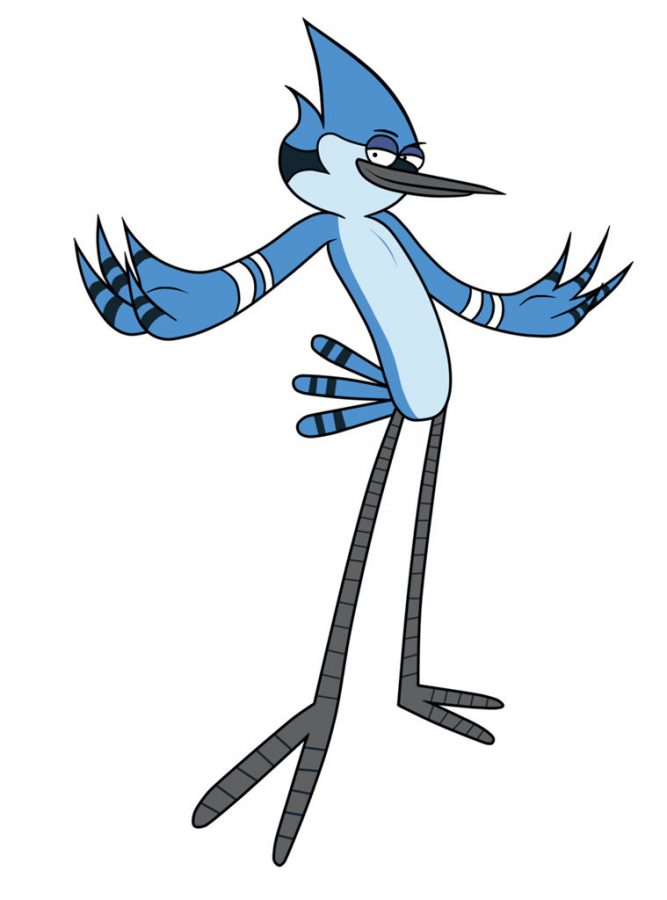Dirty Cartoons: How children’s television secretly caters to stoners
April 20, 2015
Cartoons these days are getting seedy.
Millennials can remember spending their childhood Saturday mornings watching beloved, more innocent shows that now only exist in reruns, like “Dexter’s Laboratory,” “Courage the Cowardly Dog” and “The Powerpuff Girls.”
The audience for the newest crop of cartoons, however, is hazier than that of its predecessors. The bizarre, short episodes of “Adventure Time” and “Regular Show” have quickly turned a new leaf for Cartoon Network, a television channel whose widespread appeal comes from its straight-faced adult references. While this isn’t necessarily groundbreaking for children’s shows, “Regular Show’s” deadpan references to smoking and drinking, specifically, resonate with a certain college-aged viewership that the network has previously bypassed.
On the surface, “Regular Show” looks like any other kids’ show. It follows Mordecai, a 20-something blue jay, and his buddy Rigby, a raccoon of the same age, in their work as park groundskeepers.
Yet, look deeper, and you’ll see that the show has a habit of slipping in discreet nods to a viewership closer to its protagonists’ ages (and hobbies) with Pink Floyd posters, references to stoner movie “The Big Lebowski” and 4:20 digital clock faces.
A search for “Regular Show” on the website Reddit’s “trees” section, which is a self-declared community of marijuana enthusiasts, returns numerous “look what I found!” posts of images of the same 4:20 clocks — all of which, I imagine, have to be read in a voice similar to Shaggy’s from “Scooby Doo.”
The website Cannabis Destiny, a marijuana media network, included both “Regular Show” and “Adventure Time” on its list of “Top 5 Cartoons That are More Adult Than You Think.”
“Adventure Time” follows a boy and adventurer, Finn, and his dog Jake, as they travel in the Land of Ooo. The show’s characters (including talking animals and an Ice King voiced by “Spongebob” voice actor Tom Kenny) and bizarre spontaneity, all crammed into 11-minute episodes, put “Adventure Time” in the same conversation as “Regular Show.”
These winking references, coupled with intense levels of creative talent, are what make these shows some of the best on TV right now.
While Mordecai and Rigby never explicitly smoke, their formulaic “guy messes up, leading to a psychedelic space endeavor” adventures stem from the college projects of the show’s creator, J.G. Quintel, whose own experiences, he’s said, sparked many of the on-screen plots.
Mordecai, voiced by Quintel, makes his first appearance in Quintel’s “2 in the AM PM,” while he was still at the California Institute of the Arts in 2006. The animated short is a hand-drawn film that is basically the first-ever episode of “Regular Show,” clearly only made for giggling adolescents. Of the two Quintel short films available on YouTube, “2 in the AM PM” is his only work that definitely could not run on Cartoon Network’s daily rotation, unless it was part of the channel’s late-night “Adult Swim” program.
Whereas Mordecai and Rigby are limited on “Regular Show” to kid-friendly exclamations like “What the H!” or “How are we gonna fix this S?” the short employs curse words and straightforward drug use as it follows two gas station clerks working the graveyard shift who eat candy laced with acid. Their hallucinations hilariously lead each other to become Mordecai, the blue jay, and Benson, a gumball machine who also became a central character in “Regular Show.”
After watching this short, it’s easy to see where the Emmy Award-winning “Regular Show” came from and the horizon ahead for cartoons. Quintel, who has quickly emerged as Cartoon Network’s next creative juggernaut, has also written for “Adventure Time” and “The Marvelous Misadventures of Flapjack,” two shows that share “Regular Show’s” reputation for spontaneity and tongue-in-cheek humor.
This recent wave of cartoons has helped define a new generation of television for younger viewers and has connected with older ones by blurring what can and cannot be said.
Though I’d be the first to sign a petition to bring back “Courage the Cowardly Dog,” I’m also perfectly content watching Mordecai and Rigby recover from a night of heavy “soda” drinking, completely secure in the knowledge that a seven-year-old would do the same.








